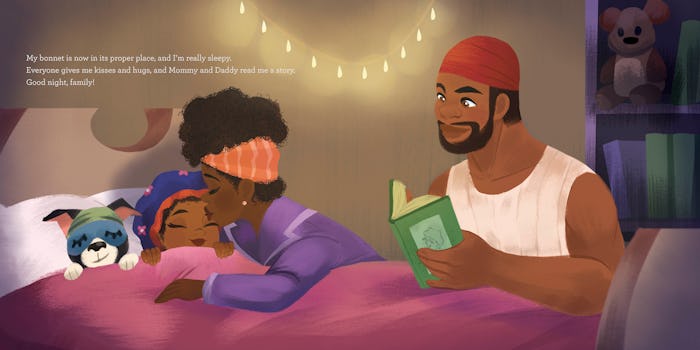Life

Bedtime Bonnets Have Made Their Way Into Picture Books — & We Are Here For It
At the end of each long day, my family look forward to our heads hitting the pillow. But before drifting into dreamland, there’s a nightly routine that we must never forget. Like clockwork, after changing into comfy jammies, we brush teeth, wash faces, moisturize hair, and tuck our precious follicles beneath a satin cap (a “durag” for the spouse who insists this is the secret to a head full of waves). I’ve been wrapping my hair since I was a wee little girl, but explaining to my 5-year-old the importance of keeping her hair protected at night has been quite the arduous task, until the arrival of Bedtime Bonnet, a children’s book by New York Times bestselling author Nancy Redd.
“In my family, when the sun goes down, our hair goes up!” starts the story, which transforms a routine practice for multigenerations of Black families into a piece of art, and a comforting story.
Prior to placing the cap on, the hair must be moisturized and secured into a style that can withstand even the most restless of sleepers. In the book, “brother twists and tightens each of his locs” while “sis combs her hair in a swirl round her head.” Twists, rollers, braids, a doobie wrap, or pineappling — every member of the family has their own unique way to prep their hair for the night. Hair coverings can be bonnets, silk scarves, durags, turbans, bandanas, or sleeping nets. And no matter the preferred covering, this type of care is precautionary. Without a nightly protective styling routine, textured hair can be damaged or the style can unravel. In my home, there have been plenty of mornings spent repairing styles that have been undone thanks to midnight shuffling with the pillows.
At times, my daughter gets frustrated by the whole process. But she is 5, so I understand that she probably just wants to go to sleep. My daughter also loves her bonnet. In fact, she’s asked several times to wear her bonnet to public places like the grocery store (especially when it’s raining because water and hairstyles don’t mix). I try not to allow respectability politics to influence when and where we wear our bonnets, but in our home they are mostly reserved for bedtime.
Bedtime bonnets have slowly made their way into pop culture as well. Reality television star, Tami Roman, delivers hilariously witty commentary about hot topics with her hair tucked away beneath a satin cap. I’ve also seen several characters on ABC’s Black-ish casually wearing bonnets and head scarves – subtleties that were likely purposefully included in the scenes. In 2018, Solange made national headlines when she wore a durag to the Met Gala; Rhianna just covered British Vogue in one. And recently, the Oscar award-winning short animated film based on Matthew Cherry’s debut picture book, Hair Love, begins with a young girl setting her larger-than-life hair free from a huge, satin bedtime bonnet.
I want my daughter to love her bonnet, which ultimately is a part of her loving herself.
At home, we are advocates of self- love, often sharing positive affirmations in front of the mirror with our bonnets on. I find myself frequently repeating these words: we wear bonnets to protect our crowning glory. Kinky, coily, and curly – our hair is distinctly beautiful and we must take care of it.
Nancy Redd, who also has a 5-year-old daughter, said she was inspired to write Bedtime Bonnet for this very reason. “I desired a realistic representation of what it means to be Black and protect your hair,” says Redd. “I want my daughter to love her bonnet, which ultimately is a part of her loving herself.”
After a delightful introduction to a bonnet-wearing family’s nighttime routine, the main character suddenly finds herself in quite the hair-raising conundrum.
“I can’t find my bedtime bonnet! I need to protect my hair from tangles and lint while I sleep.”
Oh no! This has surely happened to us, too. Once, I oiled her scalp with coconut oil, placing the hair in two large braids. She was ready to place the satin bonnet on and boom! We couldn’t find it. Beneath the pillows. In the dresser drawer. Under the bed. We searched high and low for the satin cap. It finally turned up in a dryer full of clean clothes that I forgot to store away.
Protecting the hair from tangles is one of the main reasons why we wear bonnets. “I knew that it was time for my daughter to start wearing a bonnet when her hair became increasingly tangled overnight,” says the author.
The book’s main character also looks everywhere for her bonnet, but discovers grandpa sporting the bonnet atop his shiny bald head. Phew, crisis averted! Time for a long and restful night’s sleep.
But the story isn’t over just yet.
“In the morning, when the sun comes up, our hair comes down!” The entire family smooths out their styles. They are officially ready to conquer the day. There’s nothing waking up to fresh, moisturized hair.
Bedtime Bonnet is an important addition to children’s literature because it celebrates Blackness by providing a glimpse into a common cultural practice. Illustrator Nneka Myers’ use of vibrant colors compliments Redd’s storytelling flawlessly. Reading this book is like seeing our own lives spread across the richly colored pages.
We care for our hair at night. We wear bonnets. We protect our hair. And it’s all totally normal.
However, the next time my daughter whines about having to wear her bedtime bonnet, we will revisit the book that effortlessly compliments our hair care practice. Thank you, Nancy Redd, for the gift of Bedtime Bonnet.
This article was originally published on